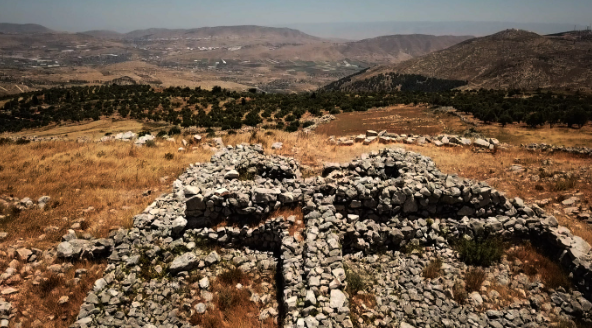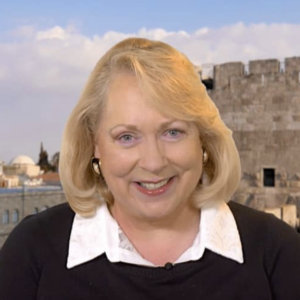Part 1 of this article can be found here.
The Crossing
For many years, archaeologists had looked for evidence of a major Israelite crossing in the area of Jericho, as it is described in the Bible. The assumption is that hundreds of thousands of Israelites crossing and settling in the area of Jericho would leave a major archaeological trace in the area. Up until very recently, such evidence had not been found. This was used by minimalist archaeologists as proof against the historicity of the events described in the Book of Joshua.
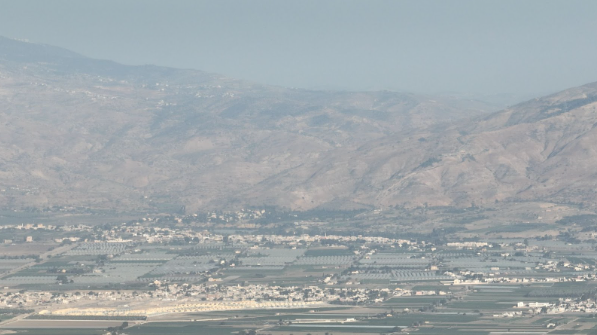
This picture changed when Professor Zertal and Dr. Shay Bar discovered – a few miles north of Jericho – a major change of population when shifting from the Late Bronze (LB) Age to the Early Iron Age.
From an area that was empty of human habitation during LB, we see hundreds of semi-nomadic encampments suddenly appearing in the area north of Jericho as we move to the Early Iron Age. The center of the settlements seems to be the Adam / Jabbok / Tirzah triangle.
Can we find any backing in the Bible to a crossing North of Jericho? Surprisingly, the answer is Yes. Many think that the miracle described in the Bible of the waters of the Jordan stopping and allowing the Israelites to cross over happened in the area of Jericho.

If we look closely at the scriptures, we find a different account of the events:
“The waters coming down from above stood and rose up in a heap very far away, at Adam, the city that is beside Zarethan, and those flowing down toward the Sea of the Arabah, the Salt Sea, were completely cut off. And the people passed over opposite Jericho.” Joshua 3:16
The Bible clearly states that the Jordan River miracle happened 17.5 miles north of Jericho. This would allow the Israelites to cross at any point north of Jericho and up to Adam/Jabbok.
So, who were the “People” that were crossing opposite Jericho? Could it be that the Bible is only referring to the fighting force of the Israelites that would eventually conquer Jericho and continue to Ai? The results of the Manasseh Survey show that the majority, if not all the Israelite camps and sheep pens appeared miles north of Jericho.
I would like to suggest that this is indeed the case. The area of Jericho was populated by Canaanites that were hostile towards the Israelite presence. It would be safer for the non-combatants to cross into an area that is empty of the Canaanite population: the area north of Jericho and up to Jabbok – the place where the miracle of the Jordan River occurred. Is there any evidence in the scriptures that points to a predominant fighting force in the area of Jericho? I believe so. Right after the crossing of the Jordan, the Israelite males are commanded to circumcise. The verses comment more than once, that it is Joshua and the “Men of War” that undertake this important commandment (Joshua 5:4-7):
“And this is the reason why Joshua circumcised them: all the males of the people who came out of Egypt, all the men of war, had died in the wilderness …For the people of Israel walked forty years in the wilderness, until all the nation, the men of war who came out of Egypt, perished, because they did not obey the voice of the Lord…”
Coming back to our topic, is it possible that the orientation of the foot-shaped enclosure sites is commemorating the Jordan river miracle at Adam-Jabok, and the crossing of the civilian Israelite population north of Jericho?

Wait! There is More!
I became obsessed with the Jabbok-Adam-Tirzah area. Could I find more Biblical events connected to this area that might be crucial in turning it into a “Holy Basin”? Although this area is rarely mentioned in the Bible, there are several events worth mentioning that could increase the sanctity of the region in the eyes of the Israelites.
The Patriarchal Traditions
It can be hard for Bible readers to disconnect from the whole Bible and try to go into the mind of an Israelite’s head in the year 1400 BC. The Israelites of that time cherished the stories of the miracles of the Exodus. But they also remembered their ancient heritage of the patriarchs Abraham and Isaac and especially Jacob – the father of the twelve tribes and the Israelite nation. In Genesis, we hear of two angelic revelations to Jacob occurring near the Jabbok River: “Jacob went on his way, and the angels of God met him. And when Jacob saw them he said, ‘This is God’s camp!’ So he called the name of that place Mahanaim.” (Genesis 32:1-2)
And the second, more important one in Genesis 32:22-31:
“The same night he arose and took his two wives, his two female servants, and his eleven children, and crossed the ford of the Jabbok…And Jacob was left alone. And a man wrestled with him until the breaking of the day. When the man saw that he did not prevail against Jacob, he touched his hip socket, and Jacob’s hip was put out of joint as he wrestled with him. Then he said, ‘Let me go, for the day has broken.’ But Jacob said, ‘I will not let you go unless you bless me.’ And he said to him, ‘What is your name?’ And he said, ‘Jacob.’ Then he said, ‘Your name shall no longer be called Jacob, but Israel, for you have striven with God and with men, and have prevailed.’ Then Jacob asked him, ‘Please tell me your name.’ But he said, ‘Why is it that you ask my name?’ And there he blessed him. So Jacob called the name of the place Peniel, saying, ‘For I have seen God face to face, and yet my life has been delivered.’ The sun rose upon him as he passed Penuel, limping because of his hip.”
The angelic revelation at Mahanaim (the area identified with Tell Edh-Dahab al-Gharbi on the western bank of the Jabbok River), and the more important revelation at Peniel (identified with Tell Edh-Dahab al-Sharki on the eastern bank), are the two crucial events that made this area in the Jordan Valley the center of spiritual and national worship to which the Israelites were oriented.
It is also worth noting another site related to Jacob, 6.6 miles northeast of the Jabbok pass. In Genesis 33:17, Jacob builds a permanent house (not a tent) and erects shacks for his flock in a place he names Sukkot. This town is also mentioned in the book of Joshua, Judges, and Kings as belonging to the tribe of Gad. Archaeologically, Sukkot is identified with Tel Deir Alla.
It occurred to me that at the Jordan Valley foot structures, the Israelites could be commemorating a number of important historical and cultural events:
- Theology – Jacob’s connection with El, the God of Abraham and Isaac
- Ethnicity – The transformation of Jacob from an individual (Jacob) to a people (Israel).
- Redemption – Jacob’s passage over the Jordan River marks the return from exile to the homeland, similar to the return of the Israelites from the exile in Egypt.
- Conquest – The victory over Esau, who left Canaan and handed it to Jacob, as a precursor to the Israelite conquest of Canaan by Joshua.

More About Adam
Can we find any sources in the Bible attesting to the holiness of this area?
In his book The Footsteps of God, Professor Zertal points out a verse in Psalm 78, which I am presenting from the Orthodox Jewish Bible (OJB) translation, that preserves the original Hebrew: “So that He forsook the Mishkan of Shiloh, the Ohel which He placed among adam (men).” (Psalm 78:60)
Zertal and other Bible scholars believe that this verse describes the destruction of the Shiloh Tabernacle and its move to an alternative location. Because this verse is built as two parallel sentences, Shiloh parallels Adam and therefore, Adam should not be translated as “men” but as the city Adam.
Another place in the Bible that could have a connection to the city of Adam and the Jordan Valley area in general is the story of the altar built by the east Jordan tribes. After the three tribes fulfill their promise to Moses, they return to their tribal lands in the east. Before crossing the Jordan, they decide to build an altar on the western side of the river at a place called Gelilot. Again, the OJB translation is needed:
“And when they came unto the Gelilot of the Yarden, that is in eretz Kena’an, the Bnei Reuven and the Bnei Gad and the half-tribe of Menasheh built there a mizbe’ach by the Yarden, a mizbe’ach gadol in appearance.” (Joshua 22:10)
The names Gelilot and Gilgal are synonymous as we can see in the northern border of Judah and the southern border of Benjamin:
“And ran from the north, and went to Ein Shemesh, and went toward Gelilot, which is opposite the ascent of Adummim, and descended to the Even Bohan ben Reuven.” (Joshua 18:17, OJB)
“And the boundary went up toward Devir from the Achor Valley, and so northward, looking toward Gilgal, which faces Ma’aleh-Adumim, which is on the south side of the wadi; and the boundary passed toward the Ein-Shemesh Spring, and ended at Ein Rogel.” (Joshua 15:7 OJB)
Is it possible that the Eastern tribes built an altar at an existing Gilgal in the Jabbok area? The Israelites – headed by the high priest Phineas – viewed such an action as a threat to the centrality of the Shiloh Tabernacle, which would justify nothing less than a civil war. Is it possible that the western Israelite tribes headed by Phineas already viewed the Jabbok-Tirzah Basin as a possible rival to Shiloh because of its centrality to the shared Israelite heritage? After all, Shiloh has a strong Patriarchal connection to Jacob, appearing in his blessing to Judah:
“The shevet (sceptre) shall not depart from Yehudah, nor a Mekhokek (Lawgiver) from between his raglayim, until Shiloh come; and unto him shall be the obedience of the amim (peoples, nations).” (Genesis 49:10 OJB)
When the Eastern tribes are confronted by Phineas, they explain that their motivation is the fear of being excluded in the future by the descendants of the western tribes from the Covenant with the Lord. Building an altar at the Jabbok-Tirzah area related to Jacob is a clear message: we are all part of one family, the sons of Jacob. We are all in Covenant with the Lord.
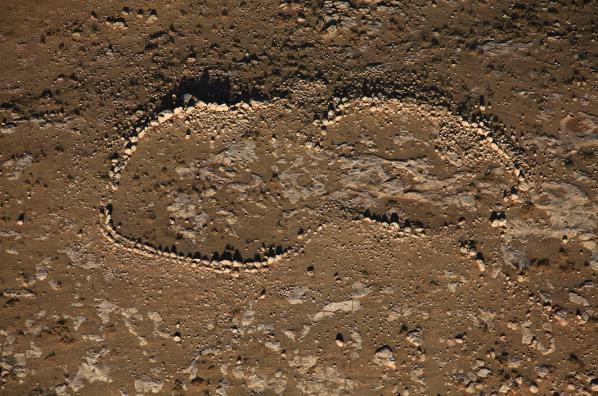
Unuk and Rimmonim
What about the other two enclosures at Unuk and Rimmonim? Can we learn anything from their theater-enclosure orientation? Unuk (Tirzah Valley) is on the highest point of the valley and has a collapsed wall that could have served as a fortification. This does not follow the “Stone way” pattern that appears on the other enclosures. Also, it does not have an adjacent slope that could serve as a theater. The Rimmonim enclosure doesn’t have a clear theater either and is far away from the central Samaria and Jordan Valley Israelite region. It is my understanding that these enclosures are not part of the 3 Jordan Valley and Ebal enclosures.
Back to Mt. Ebal
It was time to check my theory at Mt. Ebal. If I was right, the mountains of Jordan should be visible from the adjacent slope-theater of Ebal. To my surprise, not only were they visible from the higher elevation of the theater, but they were also visible from the altar itself which lay lower than the slope.
I rest my case!
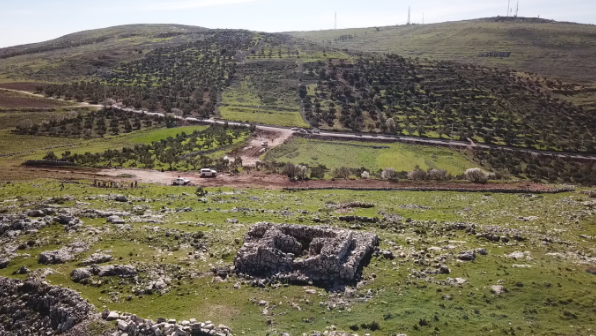
Summary
Following the orientation theory I presented, I believe that the construction of the altar compound and the orientation of the Ebal theater correspond with the Jordan Valley compounds.
The Israelites faced Jabbok which is visible to the east just behind the Kabeer ridge.
The Jabbok pass is not visible from the Shechem valley and therefore could not serve the cultic purpose that the Israelites intended for the altar that Moses commanded to build.
If I am correct, The Israelites wanted to worship their God at a place that connected them with their Patriarchal heritage and the miracle of the Jordan river crossing.
“God has spoken in his holiness:
‘With exultation I will divide up Shechem
and portion out the Vale of Succoth.’”
Psalms 60:6
